Shetland patterns are in great demand among experienced needlewomen. The process of knitting a shawl, dress, blouse or other wardrobe item is a labor-intensive process, but the final result is worth it. Detailed diagrams with descriptions, as well as recommendations from professionals, help to avoid mistakes in the process.
The true Shetland stitch is worked with yarn overs in all rows (purl + knit). If done correctly, you will get an openwork garter stitch that looks the same on both the purl and knit sides.
Shetland lace patterns
Shetland patterns with knitting needles (diagrams with descriptions allow you to master the technique of making openwork clothes, blankets, pillowcases, rugs and even various accessories on your own) are light and graceful. A beautiful lace pattern allows you to give any discreet model sophistication and exclusivity.

The needlewoman can work with both thin and thick threads. The main thing is to choose the right pattern and strictly follow the recommendations.
The step-by-step diagrams for making items with openwork Shetland patterns contain the following abbreviations:
- Loop - Fri.
- Yarn over - Nd.
- Front loop - LPt.
- Front stitch - LG.
- Garter stitch - WS.
- Row - Rw.
- Edge loop - KrPt.
- Purl stitch - purl.
- Purl row – IzR.
- Front row - LR.
The appearance of the finished product largely depends on the yarn. To make the pattern as clear as possible, you need to prepare thin, dense threads. The needlewoman should remember that when knitting Shetland patterns, it is unacceptable to create rough elements from thick threads.
At the same time, there is always room for interpretation of openwork lace. The imagination of needlewomen is not limited to using only the wool of Shetland sheep. Light, feminine Shetland patterns can be used to decorate summer dresses made of thin cotton, silk or viscose.
Merino and cashmere make excellent warm scarves, shawls and stoles (long rectangular women's capes made of fur or trimmed with fur).
All classic patterns for working with Shetland patterns are quite simple, since the main thing is to make a large number of Hd, due to which a light, magical web is formed. Knitting often has to be done with a thin thread, which is why it is easy to make a mistake even in the simplest pattern.
In this case, the Rw counter will come to the rescue. The needlewoman can also mark Rw in the notebook. You will have to work with different variations of the rhombus, which is the main pattern.
Due to the versatility of Shetland patterns, experienced needlewomen prefer to make fashionable dresses themselves, for which both long and short linings can be used. The second option looks especially advantageous if the dress is worn by a girl with long, slender legs.
A long lining is perfect for dresses where the bottom part is presented in the form of a lush, translucent skirt.
| The intricacies of working with Shetland patterns | |
| Set of loops from the border | The first and last KrPt should be knit. Due to KrPt, small knots are formed, which are slightly raised and open loops if you run a fingernail along the edge. You can insert a knitting needle into the opened loop. 2 Rw at once form 1 loop. |
| Yarn over | To make a neat ND, you need to grab the working thread from right to left with the end of the right knitting needle (moving towards you). |
| Double Hd | Double Hd is obtained if you grab the thread twice with the knitting needle, as if wrapping it around. |
| 2 Pt together with LG with a tilt to the left (stretching) | You need to remove 1 st onto the right needle (without knitting), and knit the next st on the left needle as LG. The resulting st is pulled through the removed st. |
| Knitting two loops together LG with a tilt to the right | Beginner needlewomen, when working with complex openwork, have difficulties when inserting the right knitting needle from left to right under the front sides of 2 loops. In this situation, you should insert the right knitting needle from right to left into 2 Pt and pull the Pt towards you with a little effort. After this, the loops will loosen, due to which you can pull out the knitting needle and knit 2 Pt together LG. You need to insert the right knitting needle under the front walls of 2 loops, with a movement towards you, pick up the working thread from below and pull the Pt immediately through 2 Pt. |
| 3 Pt together with LG with a tilt to the left | Without knitting, slip the first 2 sts as if they were knit stitches. But knit the third loop as a LG and pull it through the 2 slipped sts. |
| 3 Pt together LG, central Pt on top | From right to left, insert the right needle into 2 Pt and pull the loops towards you without effort. Pull the needle out smoothly to knit 3 Pt together LG. On the left side, first insert the right needle into the second Pt, then into the first and remove them from the left needle to the right without knitting. The third Pt needs to be knitted LG and pulled through the removed Pt. After this, the second Pt will be located above 1 and 3. |
| 3 Pt with a tilt to the right | With a tilt to the right, knit together 2 sts, return the resulting loop to the left needle, as well as the third st. It should be noted that in the Shetland pattern, the third loop is most often a yarn over. |
Numerous reviews from experienced needlewomen confirm that it is most convenient to knit Shetland patterns in a circle with rotary Rw. After completing the first circular Rw, the last knitted Pt should be on the right knitting needle, the first on the left knitting needle, and the working thread is left behind the work. From the left knitting needle, Pt is transferred to the right knitting needle, the first loop is returned to the left knitting needle (the thread in front of the work).
The knitting should be turned to the other side so that the thread is behind the work. There will be 1 st on the right needle, but it is left for now so that this st can be knitted last in Rw, and at this time the first st is knitted from the left needle. Due to this, a beautiful, neat, barely noticeable seam will be formed.
Having mastered the technique of knitting Shetland patterns, you can independently create various models of pullovers, jumpers, skirts, dresses. The needlewoman will be able to knit a beautiful scarf, shawl and even a festive tablecloth.
Dress based on Shetland patterns knitted
Shetland patterns look especially appropriate in cases where the needlewoman has decided to knit a feminine, light summer dress, using patterns with a detailed description of the work process.
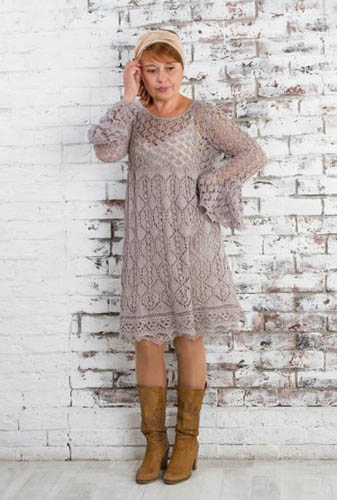
In this case, you should take into account several recommendations:
- Owners of a large bust and narrow hips should pay attention to those dress models that have a flared skirt.
- Dresses with a defined waist will look great on girls with an hourglass figure.
- At the peak of popularity in the last few years are loose, light shirt dresses of medium length. At the same time, designers recommend combining this item of women's wardrobe with leggings and wide trousers.
Due to the presence of Shetland patterns, the dress must have a lining, and such multi-layered clothing hides figure flaws well.
To knit a light long summer dress based on Shetland patterns, you need to prepare:
- Threads that are 50% cotton and the remaining 50% viscose. If you are going to knit a dress of size 44, then you need to prepare 500 g of yarn in advance.
- Circular knitting needles No.3.
- Hook.
The easiest way to start knitting a dress is from the bottom. First, you need to make a border so that you can cast on the required number of loops along its edge and knit the skirt in a circle (without seams). There should be a hollow part in the waist area, which will be needed to insert a wide elastic band. Then the product is knitted in a circle up to the neckline, into which the sleeve of the shoulder product is sewn.
To make the dress look more formal, the back can be made openwork. Each detail of the back and front is knitted separately from the armhole. The edges of the sleeves, the neck area and the edges of the hem are carefully crocheted. This model of the dress is provided with a classic dropped sleeve.
Stretch chiffon is suitable for sewing the lining. Additionally, you can sew another border to the finished lining.
The following notations are used in the diagram:
- Yarn over – 0.
- Front crossed loop - point.
- Front loop - empty cell.
- 2 cells together with a tilt to the right – /.
- 2 cells together with a left tilt - \.
- 3 cells together - triangle.
You should start knitting a dress with Shetland patterns from the border, using the following pattern:
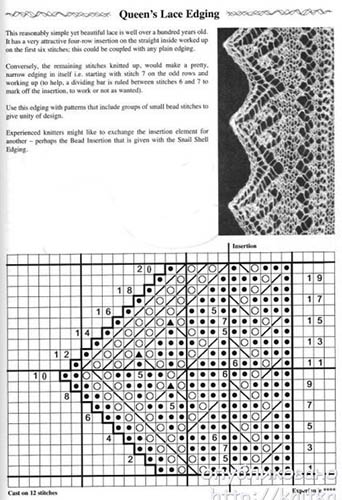
The principle of knitting the border for the lining:
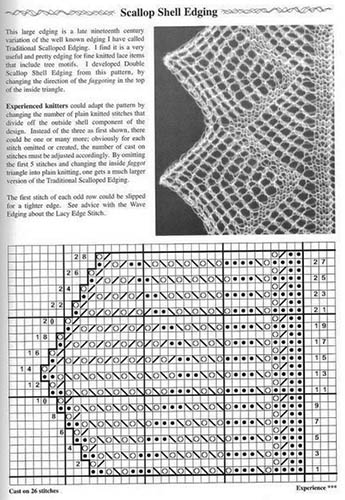
When creating a flowing skirt for a dress based on Shetland patterns, follow the following pattern:
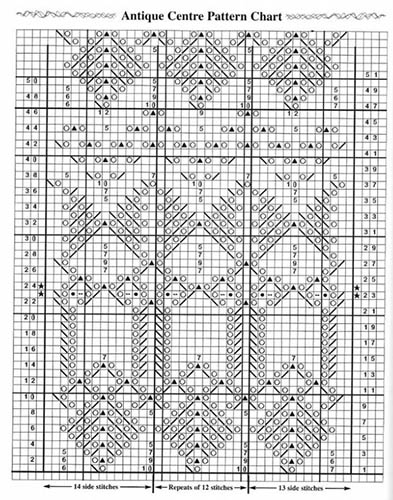
The upper part of the skirt is knitted according to the following pattern:
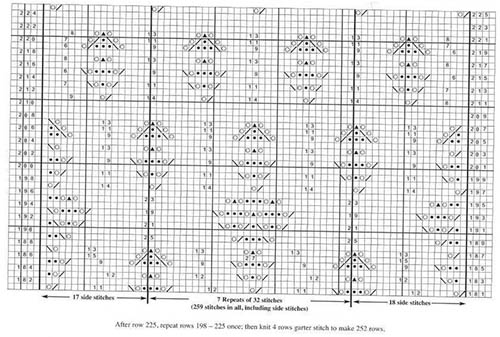
This diagram is a continuation of the top of the skirt, and also shows the principle of creating the top of the back:
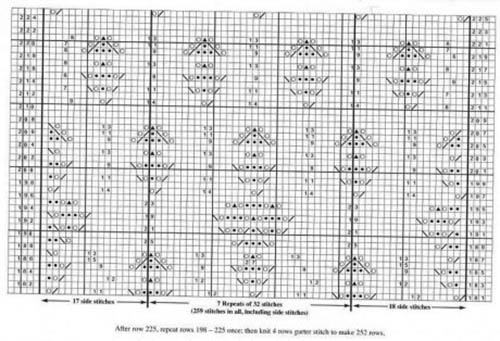
Patterns for the lower part of the back:
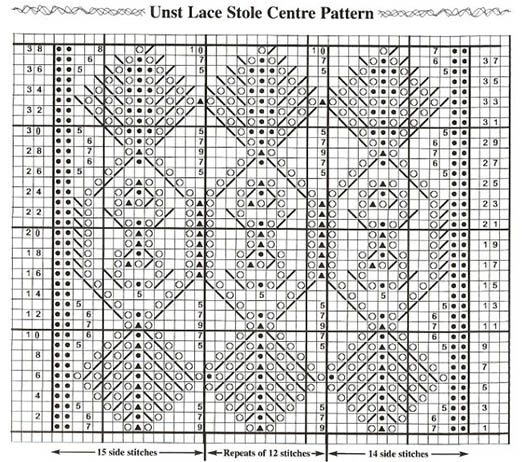
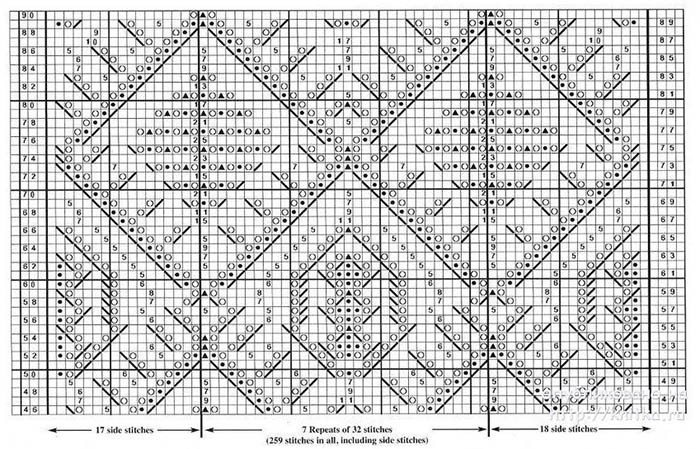
The yarn color can be any, but a lace dress with lilac Shetland patterns looks very gentle, feminine and attractive.
Plus size items
Shetland knitting patterns (diagrams with descriptions allow you to knit a beautiful, openwork thing not only for slender girls, but also for owners of curvy shapes, emphasizing all the charms of their figure) look appropriate not only when creating light summer outfits, but also when working with warm winter clothes.
To ensure that the result exceeds all expectations, you need to choose the right style from the start.
Owners of curvy hips will suit dresses of a classic cut. It is better to refuse patch pockets and shoulder pads, since otherwise the outfit will visually add a few extra kilos.
Special attention should be paid to the yarn. Stylists recommend choosing rich dark colors that will hide figure flaws. Do not refuse models of dresses with a low waist. At the same time, the product should not be short, the ideal option is when the dress covers the knees.
Dress
If the needlewoman follows the proposed pattern, she will end up with a stylish flared dress with Shetland patterns. Product size is 56/58. For work, you will need 1000 g of yarn (75% wool + 25% polyamide), as well as circular knitting needles No. 3.5-4.
Recommended knitting technique:
- LG: all LRs are knitted as LPt, and purl ones as IPt.
- Garter stitch: all knit stitches and only LP stitches are knitted.
- The openwork Shetland pattern is knitted according to the diagram.
- IG - in the process of circular knitting only IPt is done.
- Elastic band: alternately knit 1 crossed front loop (behind the back wall) and 1 IPt.
Recommended knitting density: 16 Pt – 6 cm, 32 Rw by 22 Pt – 10x10 cm.
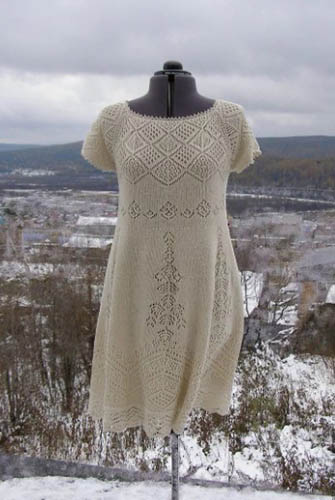
Scheme of actions:
- The hem should be knitted in a single piece in the round. To do this, cast on 504 sts on long circular needles (80 cm). Knit IG in the round and knit the openwork Shetland pattern as follows: *10 sts IG + 16 sts of the openwork pattern + 10 sts IG*. The steps should be repeated 13 times. The openwork pattern is repeated from 1 to 12 Rw.
- When the height of the fabric reaches 6 cm, you need to start decreasing: *8 Pt IG + 2 Pt together purl + 16 Pt of the openwork pattern + 2 Pt together purl + 8 Pt IG*. These actions are repeated 13 times. For 1 Rw, 28 Pt will be decreased = 476 Pt. Similarly, Pt are decreased every 10 cm from each other 5 more times = 336 Pt.
- When the height of the fabric is within 70 cm, after knitting 1 or 7 Rw of the pattern, you need to evenly decrease 64 St for 1 Rw = 272 St.
- The next 6 Rw should be knitted with a rib. The work should be divided into 2 equal parts - 136 Pt. Then each part should be knitted separately.
- The upper part of the back is knitted with LG straight and reverse Rw. In the first Rw you should add 1 Pt on both sides = 138 Pt.
- At a height of 5 cm from the elastic band on both sides in every second Rw you need to add 11 times 1 Pt for the sleeve, as well as 15 times 3 Pt and 12 times 4 Pt. The result will be 346 Pt.
- If the height of the fabric has reached 39 cm, then you can start knitting the middle 62 sts in garter stitch. The remaining sts are knitted with LG. After 2 cm, all sts are closed.
- The upper part of the front is knitted similarly to the back, not forgetting about the neckline. At a height of 37 cm from the elastic, start knitting the middle 62 sts in garter stitch. After 2 cm, close the middle 58 sts so that each side is knitted separately.
- On the inside, the outer 2 sts are knitted with garter stitch, and the remaining sts are knitted with LG. At a height of 41 cm from the elastic, the remaining 144 sts are closed. The other side is knitted symmetrically.

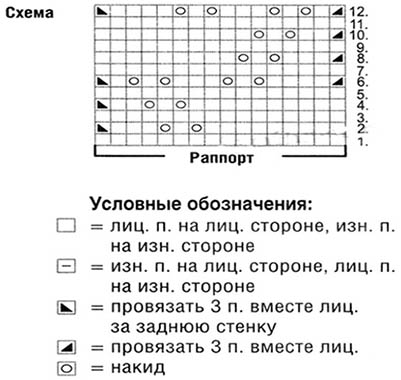
To assemble the dress, you need to lay out all the parts on a flat horizontal surface, moisten the fabric from the inside and let it dry. You need to carefully sew the top and shoulder seams of the sleeves.
To form a cuff along the edge of the sleeve, cast on 54 sts evenly and knit 2 cm in garter stitch. Close the sts. Knit the second cuff in the same way. At the final stage, it remains to complete the lower seams of the sleeves, after which you can try on the new thing.
With an openwork pattern
Shetland knitting patterns (diagrams with descriptions allow you to master the technique of creating beautiful knitted items that can diversify not only your everyday look, but also complement business, vintage and romantic styles) help make a classic dress model more elegant, feminine and interesting.
In this case, you can decorate the sleeves, collar, hem or the entire dress with openwork patterns. To knit a dress with short sleeves and inserts of small rings in the neckline area yourself, you need to prepare natural cotton yarn, knitting needles No. 2 and hook No. 2.
Additionally, you will need 3 small rings, the diameter of which should be within 3 cm. To knit a dress of size 50, you need to prepare at least 400 g of yarn.
The patterns are knitted in accordance with the proposed schemes No. 1 and No. 2. LG is created as follows: all LRs are knitted with LPt, and all IzRs are knitted with IPt.
Scheme of actions:
- To form the back, cast on 129 sts and knit 4 Rw LG. Then knit according to pattern No. 1 from 2 to 19 Rw. The next 2 Rw should be repeated 5 times, and 22 and 23 Rw should be repeated 1 time. The next 20 Rw are knitted LG.
- According to pattern No. 2, you need to knit from 1 to 26 Rw. You need to continue knitting LG. Only after 86 cm from the cast-on edge, you can close 1 time by 6 Pt, 1 time by 3 Pt, 1 time by 2 Pt and 1 time by 1 Pt to form armholes on both sides. If the length of the fabric from the beginning of the armholes is 21 cm, then all Pt are closed.
- The front part of the dress is knitted similarly to the back, only for the neckline at a height of 75 cm from the beginning of the fabric, the middle 13 Pt should be closed. Both parts are finished separately. You need to knit 16 cm LG, and then close 30 Pt and knit another 16 cm of fabric. Pt is closed.
- To form the sleeve, cast on 75 sts and knit 4 Rw LG. According to pattern No. 1, knit from 1 to 20 Rw. In 16 Rw, add 1 st once.
- According to pattern No. 1, knit 20-21 Rw to the end of the sleeve. In 24 Rw, add 1 st once. After 30 cm from the cast-on edge, close the st for the sleeve cap according to the following principle: 1 time by 6 sts, 1 time by 3 sts, 1 time by 2 sts, 20 times by 1 st. The remaining 7 sts need to be closed.

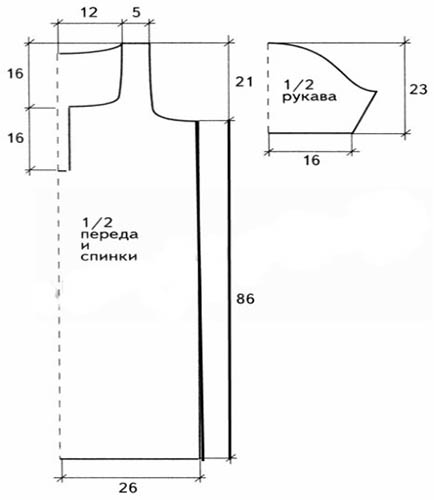
The assembly of the product begins with the formation of side and shoulder seams. You also need to sew in the sleeves, which are crocheted, and the hem of the dress is designed according to the principle of the crayfish step. You need to tie 3 rings: 1 Rw - a column without Hd + 1 Rw crayfish step. The neckline is tied as follows: 1 Rw - a column without Hd, 2 Rw - *column with Hd, 1 air Pt*.
Knit 3 Rw with a crab step. Additionally, beads can be sewn along the edge of the neck. It remains to sew the tied rings to the neckline, connecting them together with large beads.
A light option for summer
Shetland knitting patterns (diagrams with descriptions are needed not only for beginners, but also for experienced craftswomen, so that the process of creating a new thing is as clear and accessible as possible) are in great demand due to their attractive appearance.
Such patterns are actively used by needlewomen to decorate beautiful edges of products, knit airy stoles and shawls, and to decorate shoulder products. Shetland patterns are also often used in the process of creating elegant, feminine dresses for owners of curvy shapes.
To knit a light, openwork summer dress without sleeves in size 52, you need to prepare 650 g of yarn, which should be 75% cotton and 25% viscose. You will also need straight knitting needles No. 4.5 and a hook No. 4.
Knitting technique:
- LG: LR – LPt, IZR – IPt.
- The openwork pattern is knitted according to the proposed scheme. The numbers on the right side indicate only the LR, and on the left side - the IzR. In width between the arrows, you need to repeat the rapport Pt, and finish with a loop after the second arrow. In height, the actions are repeated 1 time from 1 to 52 Rw, and then repeated from 21 to 52 Rw. To create this dress, a knitting technique is used, due to which the arched edge is initially formed automatically.
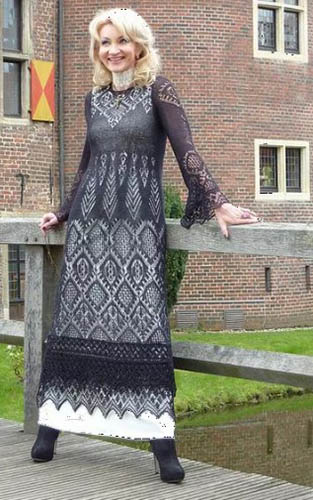
Knitting density: to create the openwork Shetland pattern, use knitting needles No. 4.5, 21 Пт and 26 Rw = 10х10 cm. For LG, use knitting needles of the same size, 20 Пт and 26 Rw = 10х10 cm.
Scheme of actions:
- To create the back, cast on 127 sts and knit 1 IzR as a face stitch. The sts should be distributed as follows: 1 KrPt, 12 Pt LG, 101 sts of the openwork pattern = 5 rapports + 1 additional Pt, 12 Pt LG, 1 KrPt.
- When the length of the fabric is 30 cm (79 Rw), you need to decrease 1 Pt on both sides for smooth rounding of the hip. In each 12 Rw, decrease 3 more times by 1 Pt = 119 Pt.
- After 15 cm (38 Rw) from the first decrease on both sides, you need to mark the end of the rounding of the hip.
- After 22 cm (58 Rw) from the marks, it is necessary to close 4 Pt for the armholes on both sides, and also in every second Rw 1 time for 3 Pt, 1 time for 2 Pt and 1 time for 1 Pt. In total there should be 99 Pt.
- Next, knit the fabric straight, continuing to work on the middle Pt (there should be 81 Pt) with an openwork pattern. On both sides, you need to knit 8 Pt LG.
- After 17 cm (44 Rw) from the beginning of the armholes for the neckline, the middle 39 Pt should be closed, both sides of the product are finished separately.
- To neatly round the neckline, you need to close 4 sts 1 time and 3 sts 2 times from the inner edge in every second Rw.
- After 3 cm (8 Rw) from the beginning of the neckline, close the remaining 20 sts of the shoulder from the outer edge. Finish the second side symmetrically.
- The front part of the dress is knitted in the same way as the back, but with a deeper neckline. To do this, after 12 cm (30 Rw) from the beginning of the armhole, close 5 sts from the inner edge in every second Rw 1 time, 3 sts 1 time, 2 sts 1 time and 1 st 5 times. From the outer edge, the shoulder sts are closed as for the back. The second side is finished symmetrically.

To assemble the dress, you need to straighten out all the prepared parts according to the pattern, moisten them and let them dry. You need to carefully complete all the seams. The neckline is tied as follows: 1 circular Rw + single crochet Hd + 1 circular Rw of the crayfish step (from left to right). The armholes also need to be tied with 1 circular Rw of the crayfish step.
Various patterns with detailed descriptions of the work process allow needlewomen to create not only light summer clothes, but also warm winter clothes. Having mastered the technique of knitting Shetland patterns with knitting needles, you can please yourself, your loved ones and relatives with beautiful handmade things.
Even with minimal knitting experience, you can make your own adjustments to the patterns to create versatile items that will flatter your figure and go well with other wardrobe items.
Video about knitting
Shetland Skirt:
